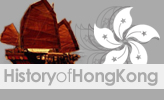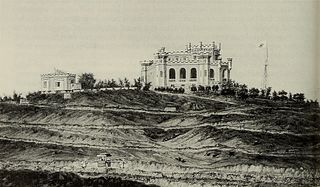
Central, also known as Central District, is the central business district of Hong Kong. It is located in the northeastern corner of the Central and Western District, on the north shore of Hong Kong Island, across Victoria Harbour from Tsim Sha Tsui, the southernmost point of Kowloon Peninsula. The area was the heart of Victoria City, although that name is rarely used today.

HSBC Main Building is a headquarters building of The Hongkong and Shanghai Banking Corporation, which is today a wholly owned subsidiary of London-based HSBC Holdings. It is located on the southern side of Statue Square near the location of the old City Hall, Hong Kong. The previous HSBC building was built in 1935 and pulled down to make way for the current building. The address remains as 1 Queen's Road Central.

Statue Square is a public pedestrian square in Central, Hong Kong. Built entirely on reclaimed land at the end of the 19th century, Statue Square consists of two parts separated by Chater Road into a northern and a southern section. It is bordered by Connaught Road Central in the north and by Des Voeux Road Central in the south.

Hong Kong (1800s–1930s) oversaw the founding of the new crown colony of Hong Kong under the British Empire. After the First Opium War, the territory was ceded by the Qing Empire to the United Kingdom of Great Britain and Ireland through Treaty of Nanjing (1842) and Convention of Peking (1860) in perpetuity. Together with additional land that was leased to the British under the Convention for the Extension of Hong Kong Territory (1898), Hong Kong became one of the first parts of East Asia to undergo industrialisation.

Hong Kong City Hall is a building located at Edinburgh Place, Central, Hong Kong Island, Hong Kong.

Sir Catchick Paul Chater was a prominent British businessman of Armenian descent in colonial Hong Kong, whose family roots were in Calcutta, India.

Sir Robert Ho Tung Bosman,, also known as Sir Robert Ho Tung, was a businessman and philanthropist in British Hong Kong. Known as "the grand old man of Hong Kong", he was knighted in 1915 and 1955 (KBE).

The General Post Office (GPO) is the headquarters of Hongkong Post. Built in 1976, it is located at Connaught Place, Central, Hong Kong. The office was adjacent to the former Star Ferry Pier, and it is adjacent to Jardine House and the International Finance Centre. The current building occupied a seafront location until 2007, since when reclamation works have led to it becoming inland.

Pedder Street is a major thoroughfare in the core of Hong Kong's Central District. It runs south–north from Queen's Road Central, continues through Des Voeux Road Central, and ends at its intersection with Connaught Road Central.

The Hongkong and Yaumati Ferry Company Limited (HYF), is a ferry company founded in 1897 in Hong Kong. It is commonly known as Yaumati Ferry. After restructuring the company in 1989, it became a subsidiary of Hong Kong Ferry (Holdings) Company Limited.

Dent & Co. or Dent's, was one of the wealthiest British merchant firms, or Hongs, active in China during the 19th century. A direct rival to Jardine, Matheson & Co, together with Russell & Co., these three companies are recognised as the original Canton Hongs active in early Colonial Hong Kong.

Arbuthnot Road is a road in Central, Hong Kong. The road begins at the Former Central Magistracy, a declared monument of Hong Kong. The road ends at the Hong Kong Zoological and Botanical Gardens.

The Hongkong Hotel was Hong Kong's first luxury hotel modelled after sumptuous London hotels. It opened on Queen's Road and Pedder Street in 1868, later expanding into the Victoria Harbour waterfront of Victoria City in 1893.

The Central and Western District located on northwestern part of Hong Kong Island is one of the 18 administrative districts of Hong Kong. It had a population of 243,266 in 2016. The district has the most educated residents with the second highest income and the third lowest population due to its relatively small size.

The Hongkong Electric Company is one of Hong Kong's two main electricity generation companies, the other being China Light & Power. The company is owned by several companies including Power Assets Holdings, State Grid Corporation of China, Cheung Kong Infrastructure Holdings and Qatar Investment Authority. It was the first company to provide electricity in Hong Kong, having run continually since the 19th century.

John Dent (1821–1892) was a British merchant with the trading firm Dent & Co., a former member of the Legislative Council of Hong Kong and Chairman of the Shanghai Municipal Council.
John Francis Chomley was an Irish businessman in Hong Kong and China in the mid-19th century. He was the first chairman of the Hongkong and Shanghai Banking Company and member of the Legislative Council of Hong Kong.
William Tarrant was a civil servant and newspaper editor in British Hong Kong. He served as Inspector of Land and Roads and subsequently Registrar of Deeds in the Hong Kong colonial administration from 1842 to 1847, but was removed from office and barred from public service owing to allegations he had raised against Colonial Secretary William Caine, which an internal government inquiry held to be fabricated. Tarrant then began a new career in journalism, purchasing the Friend of China newspaper in 1850. He became prominently involved in a scandal involving multiple senior government officers, the Caldwell affair, in 1857, and was ultimately found guilty of libel and imprisoned in 1859. He left the colony after his release in 1860, and made two attempts over the course of the 1860s to restart the Friend of China in Guangzhou and Shanghai, each proving abortive. Finally, he sold the paper in 1869 and retired to England, where he died in 1872.

Douglas Lapraik was a British watchmaker, shipbuilder and shipping magnate of Scottish origins, most famous for his business empire and his role in the founding of many of Hong Kong's early conglomerates such as HSBC.

Old City Hall, which existed from 1869 to 1933, was the first public multipurpose performance facility and cultural venue in the crown colony of Hong Kong. It housed a theatre, a library, a museum and assembly rooms. Despite its name, its function differed from a town hall in that it was used solely for community purposes and did not house any government offices.
















